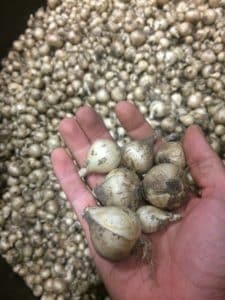BLOG: growerreport H.L. Hogervorst
Sandra and Gert-Jan Hogervorst live and work right next to the Dutch dunes. They grow potted bulb products, including hyacinths and daffodils. Gert-Jan’s father was one of the pioneers in selling potted bulb products to the auction house in Naaldwijk back in the 1970s. Read on to find out what it takes to supply the perfect bulb.
Tell us about the history of your company
My father started the nursery in 1968, cultivating tulips and hyacinths for the cut flower market. In the mid-1970s, it was decided to pot the bulbs and sell them as plants. These were sold locally, until the FloraHolland flower auction house asked whether the potted bulbs could also be auctioned. Potted bulbs were fairly new at the time, but they quickly caught on.
In the late 1980s, our barns were completely destroyed by a major fire, but this tragedy did give us an opportunity to build a more modern company. It was at this point that I joined the company. Today, I run the business together with my wife Sandra. We’ve perfected all the processes, and potted bulbs are more popular than ever.
What do you mean by perfecting the processes?
A whole range of tasks have to be dealt with before potted bulbs are ready for delivery. For example, a hyacinth bulb about to bloom may have hidden defects that will stop its flowers from developing, or cause them to bloom for a shorter time. These things aren’t always visible, so we do everything ourselves to ensure the bulbs we supply to our customers are in top condition. We grow our own bulbs, unlike some potted bulb suppliers. We start off by scooping the bulbs.
“You can rest assured that our bulbs have no hidden defects”
Can you remind us what scooping is?
We start this process by selecting a lot of very high quality, virus-free bulbs as the parents of our future bulbs. We scoop out the centre of the basal plate with a hooked knife. This has to be done very precisely, so not too deep and not too shallow. These bulbs are placed in soil, where bulblets will form in the scooped-out section. These bulblets eventually grow into large bulbs. After a planting, harvesting and drying process that takes an average of 4 years, they attain the diameter required to guarantee a beautiful flower.

I’m very strict on making sure the bulbs get the right period of rest at the appropriate temperature. There’s certainly a temptation to be flexible in the number of weeks required for this, but that can damage the quality of the bulbs. When the bulbs are removed from the soil, they have to dry and rest. They are also subject to temperature treatment, where we gradually raise the temperature to 44 ° C to kill any bacteria. When we think this period is complete, we take samples. We cut the bulb in half, and can see if the flower is present.
Your company is also known for its wide range of bulbs in ceramics, baskets and glassware. What’s the story behind this?
Potted bulbs are ideal for attractive, decorative pots. Sandra is constantly on the lookout for nice supports, and we asked Carolien from the retail brand TIMO to create some pretty products. However it does mean extra work in the company. During the delivery season, our hands are already full with meeting demand, so we’re building extra processing space.
What is your relationship with Javado?
Javado has been ordering from us since back in the 1980s. Fred is my contact at Javado. If he finds something where there’s room for improvement, he let’s us know. That suits me and my way of thinking perfectly. Together, we’ve made sure that we can work together very smoothly, even at the busiest times.
How do you see the future of potted bulbs?
Potted bulbs are easy to care for, provide colour in the winter, and are rooted in our culture. There are no problems in terms of popularity, but there are a lot of challenges. Weather conditions can ruin part of the harvest, with heavy showers posing a particular threat. We’re also strictly monitored to make our cultivation more sustainable. I support this 100%, but it does mean significant investments are necessary.
A bright future awaits those bulb growers who can best deal with these challenges.
Published on: 14 November 2019